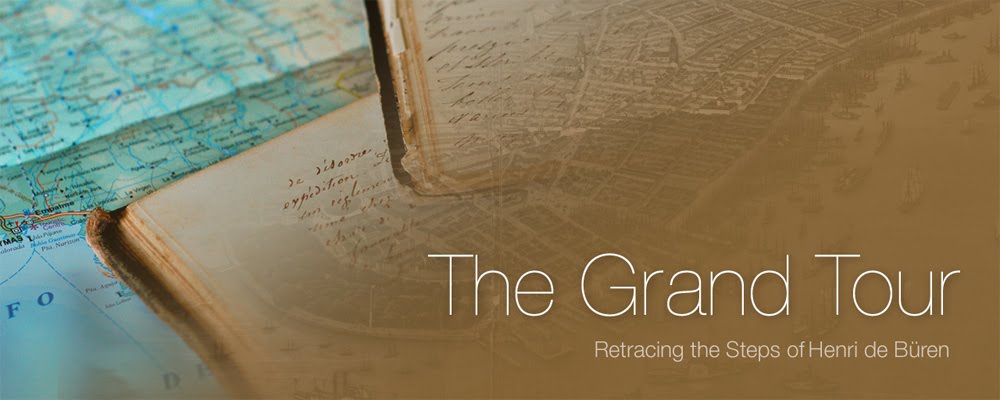Upon arriving in Boston, Henri and his travel companion Francois de Graffenried, had dinner with Arnold Guyot, and the following morning had tea with Louis Agassiz. Henri spent the next 10 days with Agassiz, accompanying him to his laboratory at Harvard as well as meeting his contemporary, Asa Gray.
Much like his father Albert de Büren, Baron de Vaumarcus, Henri was a trained Naturalist and had studied at Thaer’s School for Agriculture in Möglin, near Berlin. Both Albert and Henri knew Arnold Guyot and Louis Agassiz before they left for America; it seems likely that the two may have even come to the castle of Vaumarcus, near Neuchâtel where Henri’s father was Baron. As a trained naturalist himself, it must have been very exciting for Henri to travel to Boston and meet these two figures from his childhood as well as meet Asa Gray, someone he also held in high esteem. Darwin's theories were surely at the heart of many scientific discussions that Henri participated in with Louis Agassiz and Asa Gray during his time in Boston. Louis Agassiz, Henri's Swiss compatriot was fervently opposed to Darwin's theories, while Asa Gray was one of Darwin's greatest allies in the United States.
I have included a couple of excerpts below:
"We could not have been more graciously received by Mr. Guyot and his family. We had a delightful dinner at his residence followed by a nice walk around Boston. The next afternoon we had tea with Mr. Agassiz who then took us on a tour of his laboratory. In the midst of a very intriguing conversation about the role of science and their place in it, Mr. Agassiz told me that he had an extensive collection of native forest samples, and as he knew they were of great of interest to me, offered to let me look at them at my leisure. I could not resist his most gracious offer because his collection would be a perfect guide to acquaint myself with the local flora before I begin my trip in earnest through the Americas.
I visited Mr. Gray the other day, who received me with great warmth. He is, as you are well aware, a botanical genius, and at the same time a great man in all aspects. While we walked together in the botanical garden he collected over 50 different samples for my collection, climbing the trees himself to get me the best ones."
Historical Background

Arnold Henri Guyot (1807-1884)
Intending to enter the Church, Guyot, who was born at Boudevilliers in Switzerland, studied at the universities of Neuchâtel, Strasbourg, and Berlin, where his interests in science began to absorb him. After teaching in Paris (1835–40) he was appointed professor of history and physical geography at Neuchâtel in 1839 where he remained until 1848, when he emigrated to America. He taught first at the Lowell Technological Institute in Boston before he was appointed, in 1854, to the chair of geology and physical geography at Princeton University.

Louis Agassiz (1807-1873)
(Excerpt from University of California Museum of Palentology) In 1846, Agassiz came to the United States; in 1848 he accepted a professorship at Harvard. He immediately set about organizing and acquiring funding for a great museum of natural history. In 1859 his dream came true with the founding of the Museum of Comparative Zoology, which opened its doors in 1860. Agassiz labored for support of science in his adopted homeland; he and his colleagues urged the creation of a National Academy of Sciences, and Agassiz became a founding member in 1863. Agassiz was also appointed a regent of the Smithsonian Institution in 1863. He campaigned constantly for funds and resources for American science, and for his research projects in particular – and the funding grew and grew (although it never seemed quite enough for all that Agassiz wanted to do – and although Agassiz himself never quite finished most of his grand projects).
His philosophy of nature, aiming to understand the Divine Plan, is the last great expression of the old school of natural theology, started by men like John Ray almost two hundred years before. Natural theology had once inspired countless scientists, including Darwin and his forerunners, but by the time of publication of the Origin of Species it had largely run out of steam, unable to offer any real explanation for natural phenomena except "God made it that way." Within Agassiz's lifetime, and much to his grief, most of his students – including his son Alexander, a well-known naturalist in his own right – became evolutionists, though not necessarily Darwinians.
Yet Agassiz still made lasting contributions to evolutionary biology and systematics. His construction of a classification that did not depend on any process of evolution has been followed up in the work of the "pattern cladist" school of systematists,who try to reconstruct organismal relationships without relying on assumptions of what processes generated them. His finding of parallels between ontogeny, paleontology, and morphology was rapidly adopted by biologists like Haeckel and used to support evolution. Today, these parallels are known not to be exact correspondences, but the links between development and evolution remain an area of active research. Perhaps Agassiz's greatest lasting insight was the realization that paleontology, embryology, ecology, and biogeography had to contribute to any classification that purported to show the true relationships of organisms – even if those relationships, to Agassiz, existed only in the mind of God.
.jpg)
Asa Gray (1810-1888)
In 1842 Asa Gray joined the faculty at Harvard University, where he would teach until 1873. His donation of his thousands of books and plant specimens established Harvard's botany department. Gray was largely responsible for the unification of the taxonomic knowledge of the North American flora; his most widely used book, commonly called Gray's Manual (1848), remains a standard work. He was the chief early American supporter of the theories of Charles Darwin.












.jpg)